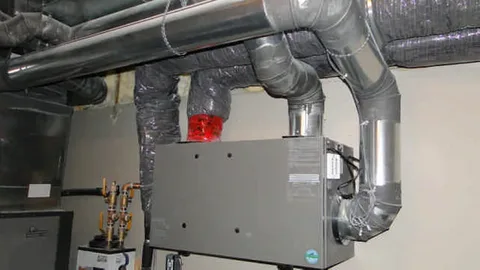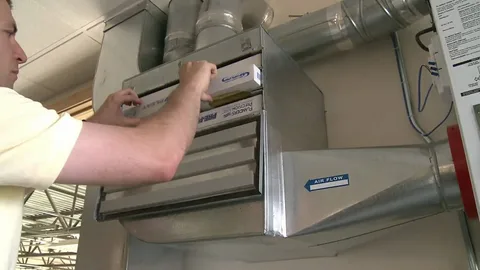As energy prices continue to climb and environmental concerns rise, many homeowners seek innovative ways to reduce their energy consumption without sacrificing comfort. One such method gaining popularity is home heat recovery. A home heat-recovery system can dramatically transform your household’s energy efficiency by capturing and reusing heat that would otherwise be wasted. This blog post will explore residential heat-recovery systems, their features, types, benefits, and more.
Understanding the Basics of Home Heat-Recovery
Understanding the basics of home heat-recovery involves recognising how these systems capture and reuse thermal energy to enhance energy efficiency. Home heat-recovery works through a heat-exchanger that facilitates heat transfer between outgoing and incoming air streams. As stale indoor air is expelled, it transfers heat to the fresh air entering the home. This process effectively warms the incoming air in winter and can cool it in summer, reducing the load on heating and cooling systems.
Heat-recovery systems improve indoor air quality by maintaining a continuous flow of fresh air and removing pollutants and allergens. These systems are designed to operate quietly and efficiently, making them an attractive option for modern homes. Homeowners can choose between various configurations, including balanced ventilation systems that provide equal amounts of fresh and stale air or energy recovery ventilators that also manage humidity levels.
Installation can be tailored to fit both new constructions and existing homes, making it a versatile choice for enhancing energy efficiency. Regular maintenance, including filter changes and system checks, is essential to ensure optimal performance.
Features of a Home Heat Recovery System
A home heat recovery system is designed to enhance energy efficiency and indoor air quality through several key features. One of the primary components is the heat exchanger, which facilitates thermal energy transfer between incoming and outgoing air streams without mixing them. This allows for the recovery of heat from stale indoor air, which is then used to warm the fresh air entering the home, reducing the overall energy required for heating.
Additionally, many systems include filters that help remove dust, allergens, and pollutants from the incoming air, promoting a healthier indoor environment. Another essential feature is continuous ventilation, which ensures a steady supply of fresh air while minimising energy loss. This constant airflow helps maintain consistent indoor temperatures and humidity levels, contributing to overall comfort.
Some advanced heat-recovery systems come equipped with intelligent controls and sensors that monitor indoor and outdoor conditions, automatically adjusting the system’s operation for optimal performance and energy savings. Moreover, the compact design of many heat-recovery units makes them suitable for various home layouts, allowing for easy installation in both new constructions and existing homes.
Different Types of Home Heat-Recovery Systems
Home heat-recovery systems come in several types, each designed to enhance energy efficiency and indoor comfort in unique ways. One of the most common systems is the heat-recovery ventilator (HRV), which transfers heat between incoming and outgoing air streams. This system is particularly effective in climates with extreme temperatures, as it ensures that fresh air is tempered before entering the living space, reducing the workload on heating and cooling systems.
Another popular option is the energy-recovery ventilator (ERV), which transfers heat and manages humidity levels. This is beneficial in humid climates, as it helps prevent excess moisture buildup while providing fresh air. ERVs capture moisture from the outgoing air and transfer it to the incoming air, ensuring a balanced indoor environment.
Ductless heat-recovery systems are also gaining traction, especially in homes without ductwork. These systems use individual units to recover heat in specific rooms, offering flexibility and targeted efficiency. There are whole-house heat pumps combining heating and cooling with heat-recovery capabilities. These systems extract heat from the air or ground and can provide heating and cooling as needed, making them a versatile choice for energy-conscious homeowners.
Benefits of Installing Residential Heat Recovery Systems
A residential home heat-recovery system offers myriad benefits, enhancing comfort and sustainability.
Improved Indoor Air Quality
It improves indoor air quality by constantly providing fresh air while expelling pollutants and allergens. This is particularly advantageous for households with allergy sufferers or respiratory issues.
Consistent Indoor Temperature
Maintaining a consistent indoor temperature year-round eliminates hot and cold spots, creating a more comfortable living environment.
Reduced Workload on Existing Systems
The residential heat recovery systems reduce the workload on existing heating and cooling units, potentially extending their lifespan and lowering maintenance costs.
Convenience and Control
Furthermore, advanced models with intelligent technology allow for remote monitoring and control, adding convenience to energy management.
Long-Term Savings
In addition to the immediate benefits, installing a heat-recovery system can lead to significant long-term savings on energy bills.
How Heat-Recovery Impacts Energy Bills
Heat-recovery systems significantly reduce homeowners’ energy bills by optimising the use of thermal energy. These systems minimise the energy required for heating and cooling by capturing and reusing waste heat from indoor air. During colder months, a heat-recovery system transfers warmth from stale indoor air to incoming fresh air, reducing the load on heating systems. This process allows homes to maintain comfortable temperatures without excessive energy expenditure.
In warmer months, heat-recovery systems can also help cool incoming air by expelling indoor heat, which lightens the burden on air-conditioning units. The result is a more efficient temperature regulation that directly translates to lower energy consumption and reduced utility costs.
Moreover, heat-recovery systems enhance indoor air quality by providing continuous ventilation. This ensures a fresh air supply while minimising the energy needed to maintain comfortable temperatures. As energy prices continue to rise, adopting heat-recovery technology offers homeowners a way to achieve significant savings over time.
 Integrating Whole House Heat Recovery System
Integrating Whole House Heat Recovery System
Integrating a whole house heat-recovery system can significantly enhance energy efficiency and indoor comfort. This type of system works by capturing and reusing heat from outgoing air, transferring it to incoming fresh air through a heat exchanger. To begin the integration process, homeowners should assess their existing HVAC system to determine compatibility. A professional evaluation can identify the best type of heat-recovery system suitable for the specific layout and needs of the home.
Once a system is selected, installation typically involves setting up ductwork that connects the heat-recovery unit to the main living spaces. This allows for the efficient circulation of air throughout the home. The integration of intelligent controls can optimise the performance of the whole house heat recovery system. These controls monitor indoor and outdoor temperatures, adjusting operations based on real-time conditions to maximise energy savings.
Homeowners can also benefit from regular maintenance, ensuring that filters are clean and the system operates efficiently. Furthermore, incorporating a whole house heat-recovery system improves indoor air quality by providing consistent ventilation and reducing indoor pollutants. This technology enhances comfort and aligns with sustainable living practices, as it reduces overall energy consumption.
Maximising Efficiency with Heat-Recovery
Maximising efficiency with heat-recovery systems is essential for sustainable energy consumption in homes and buildings. These systems capture and reuse thermal energy that would otherwise be wasted, significantly reducing the energy required for heating and cooling. To optimise efficiency, it’s crucial to ensure that the heat-recovery unit is appropriately sized for the space it serves. An undersized or oversized system can lead to inefficiencies and increased energy costs.
Regular maintenance is another critical factor in maximising efficiency. Homeowners should check filters and clean the heat-exchanger components to ensure unobstructed airflow and optimal performance. Integrating smart technology can enhance system efficiency by allowing real-time monitoring and automatic adjustments based on indoor and outdoor conditions. Strategic placement of the heat-recovery unit can also influence its performance.
Locating it in a central area of the home facilitates better airflow and heat distribution. Furthermore, pairing the system with other energy-efficient technologies, such as programmable thermostats and appliances, can yield even more significant energy savings. By focusing on these strategies, homeowners can effectively maximise the efficiency of their heat-recovery systems, leading to reduced energy costs, improved indoor air quality, and a smaller carbon footprint, contributing to a more sustainable living environment.
Choosing the Right Home Heat Recovery Ventilation System
Selecting the optimal home heat recovery ventilation system involves several key considerations to ensure it meets your household’s needs.
Assessing Your Home’s Size and Layout
Start by evaluating your home’s size and layout. Larger homes may require more robust systems to ensure effective heat recovery and air distribution.
Climate Considerations
The climate also plays a significant role; for instance, energy recovery ventilation (ERV) systems are particularly beneficial in humid environments due to their moisture management capabilities.
Budget Considerations
Budget is another critical factor, but balancing upfront costs with long-term energy savings and potential maintenance expenses is essential. Engaging a professional for an in-depth assessment can help identify the most suitable system.
Quality and Certification
Factors like efficiency ratings, ease of integration with existing home infrastructure, and intelligent technology features for enhanced control and monitoring should be considered. Certification by recognised standards can also be a good indicator of system quality and reliability.
Long-Term Value
Ultimately, the right choice will offer energy efficiency, improved indoor air quality, and overall comfort, making it a worthwhile investment in your home’s sustainability and your family’s well-being.
Conclusion
In conclusion, implementing home heat-recovery systems significantly optimises energy consumption and enhances overall comfort. By efficiently capturing and reusing thermal energy, these systems reduce reliance on traditional heating and cooling methods, leading to lower energy bills and a smaller carbon footprint. Homeowners benefit from improved indoor air quality and consistent temperature control, making heat-recovery an essential investment. As sustainability becomes increasingly important, adopting these technologies positions homes for a more energy-efficient future.
FAQs
How does home heat-recovery work?
Home heat-recovery operates by utilising a heat exchanger. This allows warm, stale air to transfer heat to incoming cooler air without mixing the two air streams. This process enables the system to preheat or cool incoming air, optimising the overall energy usage in the home.
What are the benefits of home heat recovery?
The benefits of home heat recovery include reduced energy costs, improved indoor air quality, and enhanced comfort. By recovering heat that would otherwise be lost, these systems lower the demand for heating and cooling systems, leading to significant energy savings. Additionally, continuous ventilation helps remove indoor pollutants.
Can home heat-recovery be installed in existing homes?
Yes, home heat-recovery systems can be installed in both new constructions and existing homes. However, it’s essential to consult a professional to assess the home’s existing HVAC system and determine the best configuration for optimal performance.
How often should home heat-recovery systems be maintained?
Regular maintenance is crucial for home heat-recovery systems to operate efficiently. To ensure the system functions effectively, homeowners should check and replace filters every three months and schedule professional inspections at least once a year.
Are there any drawbacks to home heat-recovery?
While home heat-recovery systems offer many advantages, potential drawbacks include initial installation costs and the need for regular maintenance. However, the long-term energy savings and improved comfort often outweigh these concerns, making them a worthwhile investment.
| Other Good Articles to Read |
| Blogs-Peoples |
| Bryan Smith Blogs |
| intellect blogs |
| the fault in our blogs |
| blogs eu |
| oz forums |
| recruitment blogs |
| zet blogs |
| id blogs |
| Blog Studio legale |
| blogs map |
| Related Business Listings |
| Contact Directory |
| Local Business Profiles |
